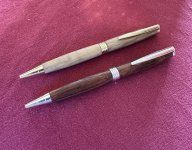Hi all
I have a couple of Newbie CA questions for you more experienced pen turner's
So being new I have been watching loads of YouTube videos on the application and finishing of CA for finishing pens and have a couple of questions?
1. Most seem to just apply the CA direct to the wood but a few use a Boiled Linceed oil/CA mix for the first coat, any idea why they do that.
2. Probably running before I can walk I gave it ago tonight and it didn't end well, I applied about 8 coats using an activator between coats, then sanded and polished to a nice glass like finish, which I was well pleased with, the problems began when I tried to assemble the pens. I did remember to sand the ends of the tubes to remove any CA build up but on the first attempt the CA cracked like broken glass and on the second attempt the CA cracked around the end as the end cap was pushed in.
I know I should expect it to go right first time but I can't see what I did wrong, any thoughts.
Could it be the type of CA I used, being a generic low cost bottle from Wilco, would I get better results using a branded CA, ie, loctite, Starbond, Titebond etc or are they all generally the same thing.
Could it be that I don't yet have a pen press and just use my bench vice to press the parts together, could it be as simple as I am using too much force?
Any other thoughts on what I am doing wrong, or are these failures quite common with CA and the youtubers keep quite about their failures.
Thanks for any help with this.
Paul
I have a couple of Newbie CA questions for you more experienced pen turner's
So being new I have been watching loads of YouTube videos on the application and finishing of CA for finishing pens and have a couple of questions?
1. Most seem to just apply the CA direct to the wood but a few use a Boiled Linceed oil/CA mix for the first coat, any idea why they do that.
2. Probably running before I can walk I gave it ago tonight and it didn't end well, I applied about 8 coats using an activator between coats, then sanded and polished to a nice glass like finish, which I was well pleased with, the problems began when I tried to assemble the pens. I did remember to sand the ends of the tubes to remove any CA build up but on the first attempt the CA cracked like broken glass and on the second attempt the CA cracked around the end as the end cap was pushed in.
I know I should expect it to go right first time but I can't see what I did wrong, any thoughts.
Could it be the type of CA I used, being a generic low cost bottle from Wilco, would I get better results using a branded CA, ie, loctite, Starbond, Titebond etc or are they all generally the same thing.
Could it be that I don't yet have a pen press and just use my bench vice to press the parts together, could it be as simple as I am using too much force?
Any other thoughts on what I am doing wrong, or are these failures quite common with CA and the youtubers keep quite about their failures.
Thanks for any help with this.
Paul



